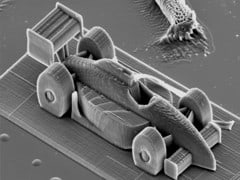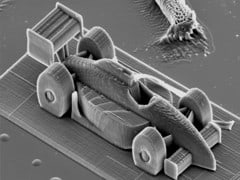
For those interested in atomically precise manufacturing, 3D-printing is an interesting microscale technology for making centimeter-scale objects. We commented on this technology a few months ago with the introduction of two competing technologies for printing complex digitally-designed plastic consumer items. Foresight Senior Associate Charles Vollum sends word of the extension of 3D-printing to nanoscale (approximately 100 nm) resolution. In addition, the new procedure is much faster and enables true 3D fabrication, without requiring layer-by-layer fabrication. A hat tip to KurzweilAI for describing this Vienna University of Technology news release “3D-printer with nano-precision“:
Printing three dimensional objects with incredibly fine details is now possible using “two-photon lithography”. With this technology, tiny structures on a nanometer scale can be fabricated. Researchers at the Vienna University of Technology (TU Vienna) have now made a major breakthrough in speeding up this printing technique: The high-precision-3D-printer at TU Vienna is orders of magnitude faster than similar devices (see video). This opens up completely new areas of application, such as in medicine.
The video shows the 3d-printing process in real time. Due to the very fast guiding of the laser beam, 100 layers, consisting of approximately 200 single lines each, are produced in four minutes.
Setting a New World Record
The 3D printer uses a liquid resin, which is hardened at precisely the correct spots by a focused laser beam. The focal point of the laser beam is guided through the resin by movable mirrors and leaves behind a polymerized line of solid polymer, just a few hundred nanometers wide. This high resolution enables the creation of intricately structured sculptures as tiny as a grain of sand. “Until now, this technique used to be quite slow”, says Professor Jürgen Stampfl from the Institute of Materials Science and Technology at the TU Vienna. “The printing speed used to be measured in millimeters per second – our device can do five meters in one second.” In two-photon lithography, this is a world record. …
Photoactive Molecules Harden the Resin
3D-printing is not all about mechanics – chemists had a crucial role to play in this project too. “The resin contains molecules, which are activated by the laser light. They induce a chain reaction in other components of the resin, so-called monomers, and turn them into a solid”, says Jan Torgersen. These initiator molecules are only activated if they absorb two photons of the laser beam at once – and this only happens in the very center of the laser beam, where the intensity is highest. In contrast to conventional 3D-printing techniques, solid material can be created anywhere within the liquid resin rather than on top of the previously created layer only. Therefore, the working surface does not have to be specially prepared before the next layer can be produced (see Video), which saves a lot of time. A team of chemists led by Professor Robert Liska (TU Vienna) developed the suitable initiators for this special resin. …
Because of the dramatically increased speed, much larger objects can now be created in a given period of time. This makes two-photon-lithography an interesting technique for industry. At the TU Vienna, scientists are now developing bio-compatible resins for medical applications. They can be used to create scaffolds to which living cells can attach themselves facilitating the systematic creation of biological tissues. The 3d printer could also be used to create tailor made construction parts for biomedical technology or nanotechnology.
We are still three orders of magnitude away from atomic precision and limited in the choice of materials to one polymer; however, the more useful 3D printing technology becomes, the more interest to extend it toward general purpose atomically precise manufacturing.
—James Lewis, PhD

